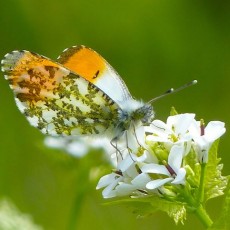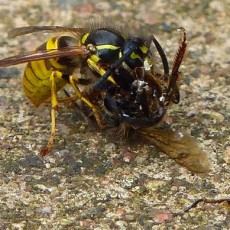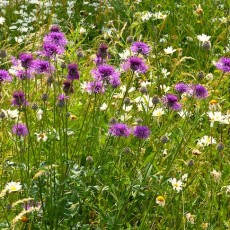Here in the UK, it may surprise you to learn that we have 5 species of ‘true’ cricket, 13 species of bush-cricket, and the mole-cricket. There are also 11 species of grasshopper. Crickets and grasshoppers are related species and belong to the orthoptera order.
How grasshoppers and crickets sing
The chirring sounds of grasshoppers and chirping sounds of crickets are within the range of human hearing and are part of the orchestral sound of summer, woven with birdsong. Crickets sing by rubbing their wings together and is called stridulation. Grasshoppers stridulate by rubbing their long hind legs against their wings. The Roesel’s bush-crickets in this clip are stridulating. You may be able to hear their wings being rubbed together.
How do grasshoppers and crickets hear?
Grasshoppers are able to detect sound through little ‘ears’ at the base of their abdomen, whereas crickets have them on their front legs. It is amazing to think that these insects don’t hear through ears on their head like us! The majority of crickets are crepuscular (which means they are active at dusk) whereas grasshoppers can be seen out and about during the day. Both are very well camouflaged and it often takes awhile to be able to spot them amongst long grasses, or plants, that they are clinging to or resting on. Unless they jump or run out of the way.
Occasionally crickets fly!
I at first thought it was a dragonfly. But this is footage of the rare macropterous (with fully developed wings) form diluta of Roesel’s bush-cricket which flew past me at shoulder height.
They usually make up as little as 1% of the population in some years, but can occur in high numbers in very hot summers, and 2019 was a very hot summer. Look at those elegant wings!
So, is it a cricket or grasshopper?
Both species have different markings in shades of green and/or brown.
Both species have powerful hind legs for jumping, although bush crickets are less athletic.
The easiest way to tell them apart is by looking at their antennae: a cricket’s antennae is always much longer than its body, whereas a grasshopper’s is always short, as you can see in these images.
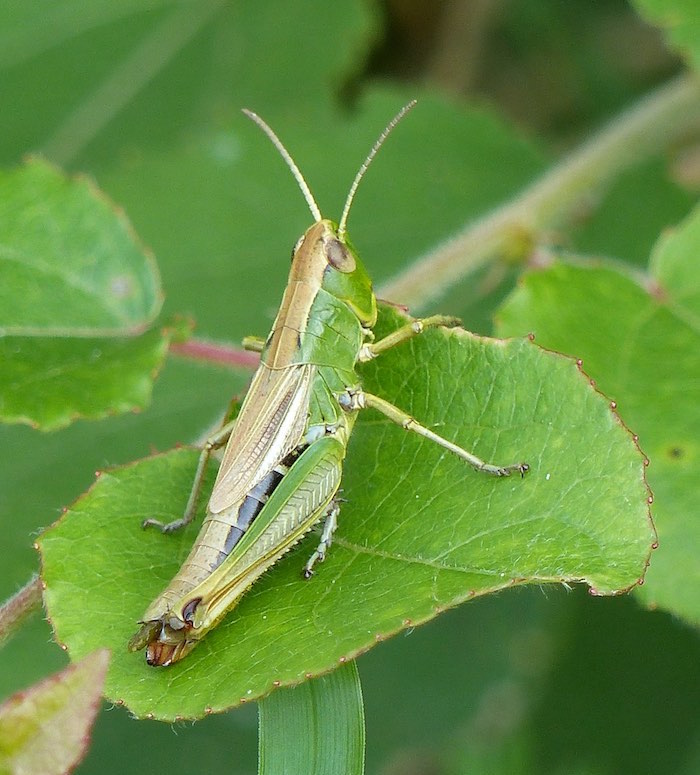
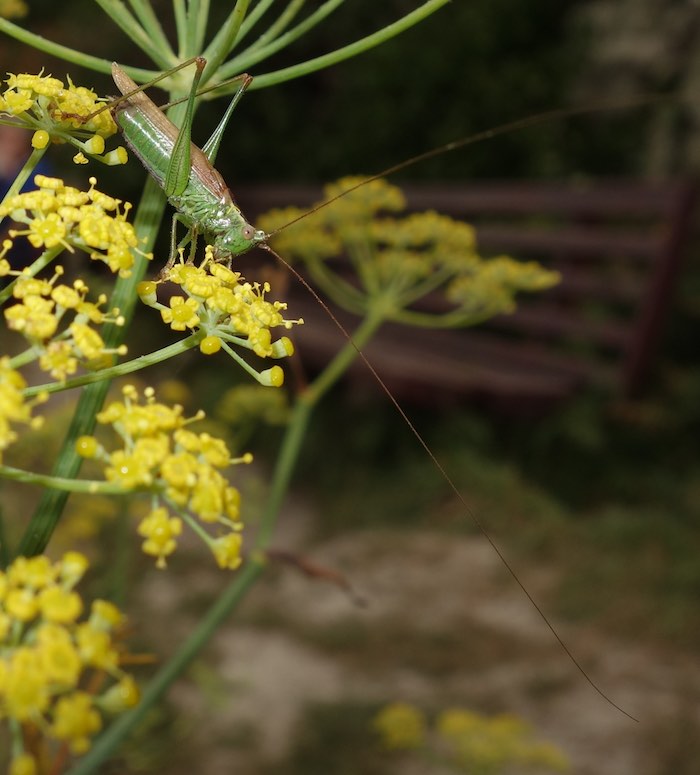
The largest crickets: great green bush-cricket and mole cricket
The great green bush-cricket and critically endangered mole-cricket are the largest of these species at 5cms long. Great green bush-crickets are a favourite of mine. They are masters of camouflage for such a large insect due to being a perfect colour match to summer’s meadows, so are difficult to find. On one occasion, I was amazed to see one biting through a field scabious wildflower and then collecting it.
I can go through a summer and early autumn hearing one, but not being able to locate one, as was the case this year: no sightings, just the strident call.
Mole-crickets are very noisy and darker in colour, so they are easier to spot. All the other crickets are around 2cm–3cm and grasshoppers are around 1cm–2cm.
Species of cricket
Among the ‘true’ crickets, the field-cricket, wood-cricket and scaly-cricket are established natives (with a slight question mark against the last one). So just three species, all of which are rare and confined to the south. A fourth species, the house-cricket is non-native. This cricket has been around a long time, possibly arriving with the returning Crusaders in the 13th Century (Kevan, 1955): it is still widespread in England and Wales, but scarcer in Scotland. Once a familiar household insect, it is the original Dickensian ‘Cricket on the Hearth’! The fifth species, the Italian tree-cricket, seems to have arrived naturally in the Channel Islands and Dungeness in the last couple of years. It is worth remembering that numbers of species are always a bit fluid because of artificial introductions and new arrivals.
There are ten species of established native bush-crickets, plus three more which have arrived naturally and bred within the last decade or so (southern oak, large cone-head and sickle-bearing bush-cricket). There are no alien bush-crickets which have shown any tendency to establish themselves at all.
Although the mole-cricket is said to be permanently on the point of extinction with only one population in the New Forest, the current status of mole-cricket is debatable: many contemporary records are based on introductions with plant material rather than its historical status as a native species. It was once much more widespread, and although never common it was familiar enough to ordinary people to have acquired a range of folk names. John Curtis’s British Entomology of the 1820s gives ‘Jarr-worm, Eve-churr and Earth-crab’ as alternative names; and it is famously described in Gilbert White’s Natural History of Selborne. That leaves one species, the camel-cricket which is very much an alien and now more or less exterminated.
The full list with images of crickets and grasshoppers you can expect to find in the UK can be found here: https://en.wikipedia.org/wiki/List_of_Orthoptera_and_allied_insects_of_Great_Britain
Habitat that crickets and grasshoppers seek
Both species are common in many types of habitat, including grassland, hedges, open woodland rides, natural gardens and allotments, but are not found on short lawns. Allowing longer grasses in these habitats and on roadside verges helps them to thrive. They play essential roles in ecosystems as a food source for rare or declining birds: such as grey partridges, skylarks, cirl buntings, corncrakes and common cranes. They are also preyed upon by lizards, slow worms, small mammals such as harvest mice, and spiders: especially large web-spinning spiders and wolf spiders. So clearly these insects are not only delightful to observe, but are an essential part of the web of life.
Crickets are natural pesticides!
Grasshoppers tend to feed mostly on grass. Whereas crickets help to control pests, by feeding on aphids and other insects, as well as plants. So rejoice if you find one of these fascinating insects in your farmland, garden, or allotment! If you stop using pesticides you will find that nature will do the job for you, as crickets, wasps, dragonflies, damselflies, birds and bats feast on them.
How you can help wildlife
Did you know that the UK is one of the most nature depleted countries in the world? Our gardens are vital habitat for wildlife, providing wild corridors which they can use to access neighbouring gardens and the wider countryside. The UK’s gardens provide more space for nature than all the National Nature Reserves (NNR’s) put together!
So why not give nature a helping hand, by compassionately turning your garden into a nature reserve? You could start with wildlife attracting projects such as an orchard meadow, or hedgerow, pond, or native wildflower meadow. Or plant native trees to attract birds, mammals and invertebrates into your very own nearby wild. If you are not sure what to plant in your garden Habitat Aid will offer advice and can supply native plants.
I have never regretted turning part of my garden lawns into a mini wildflower meadow and orchard meadow, as I have the joy of grasshoppers, crickets, many kinds of bumblebee, solitary bee and butterfly visiting them throughout the spring and summer, including birds and bats who arrive to feast on the insects! Sometimes I see fascinating insects such as longhorn beetles, or hedgehogs foraging there.
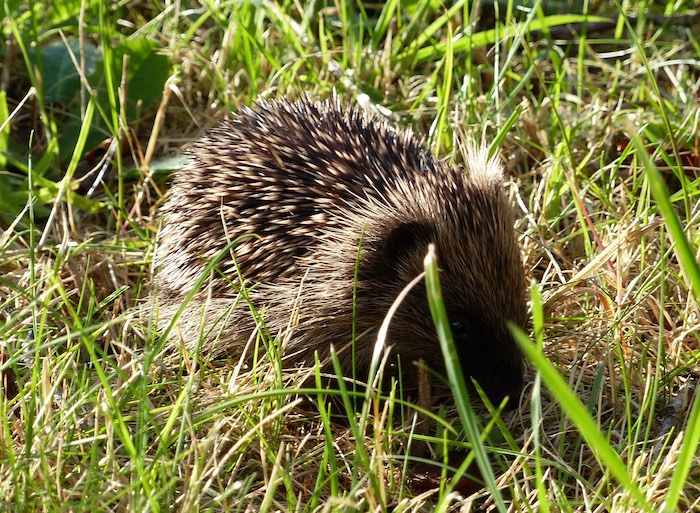
Listening to exquisite birdsong whilst enjoying the tapestry of wildflowers and ballet of insects is soul nourishing. It is also health-giving, as it is another form of forest bathing. Wildflowers are constantly emitting healing essences in the same way that trees do. So sow your own wildflower meadow, or orchard meadow, and partake in some meadow bathing. All you have to do is walk through a pathway, sit beside it, or open your ground floor windows and you will begin to feel at ease as the meadow’s perfume envelopes you and you breathe in the healing essences!
Grasshoppers and crickets have inspired poetry
In Keats’s poem The Grasshopper and the Cricket he explores how the beauty of nature persists and never entirely disappears during his nature connected age. He examines the progression of the seasons through natural signs, particularly the joy of finding grasshoppers in summer and the house-cricket chirping near the stove in winter. Even when it seems nature is resting, her exquisite poetry is never finished.
On the Grasshopper and Cricket – John Keats, 1795 -1821
The poetry of earth is never dead:
When all the birds are faint with the hot sun,
And hide in cooling trees, a voice will run
From hedge to hedge about the new-mown mead;
That is the Grasshopper’s—he takes the lead
In summer luxury,—he has never done
With his delights; for when tired out with fun
He rests at ease beneath some pleasant weed.
The poetry of earth is ceasing never:
On a lone winter evening, when the frost
Has wrought a silence, from the stove there shrills
The Cricket’s song, in warmth increasing ever,
And seems to one in drowsiness half lost,
The Grasshopper’s among some grassy hills.
Acknowledgements:
Thanks to David Williams, Orthoptera County Recorder, Shropshire for his advice.
Special thanks to Ian Beavis @iancbeavis, Natural history specialist & Entomologist, for editing and providing some fascinating facts!
If you enjoyed this article and found it helpful, we’d love you to let us know by clicking a button below – thank you!

